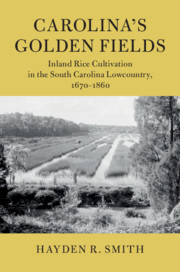Book contents
- Carolina’s Golden Fields
- Cambridge Studies on the American South
- Carolina’s Golden Fields
- Copyright page
- Dedication
- Contents
- Figures
- Table
- Acknowledgments
- 1 Introduction
- 2 Simple Reserves
- 3 The “Golden Mines of Carolina”
- 4 “To Depend Altogether on Reservoirs”
- 5 “The Rice Fields which Are Sown Have Been Partially Flowed”
- 6 Inland Rice Cultivation and the Promise of Agricultural Reform
- 7 Epilogue
- Appendix
- Bibliography
- Index
5 - “The Rice Fields which Are Sown Have Been Partially Flowed”
Water and Labor Management during the Antebellum Period
Published online by Cambridge University Press: 28 October 2019
- Carolina’s Golden Fields
- Cambridge Studies on the American South
- Carolina’s Golden Fields
- Copyright page
- Dedication
- Contents
- Figures
- Table
- Acknowledgments
- 1 Introduction
- 2 Simple Reserves
- 3 The “Golden Mines of Carolina”
- 4 “To Depend Altogether on Reservoirs”
- 5 “The Rice Fields which Are Sown Have Been Partially Flowed”
- 6 Inland Rice Cultivation and the Promise of Agricultural Reform
- 7 Epilogue
- Appendix
- Bibliography
- Index
Summary
Chapter 5 explains how aspiring planters used inland rice plantations as a way of entering the planter aristocracy before the Civil War. Land values, as they relate to shifts in technology and agricultural output, reveal the accessibility for an emerging upper middle-class to enter into the planter elite. During the antebellum period, most productive rice lands were beyond the means of professionals and merchants striving to enter into the upper echelons of society. When put up for sale, tidal rice plantations received a premium price, and most desired lands stayed in families through inheritance or marriage. Land, and rice production, was a means to reflect one’s status and define one’s title in the rigid Lowcountry social hierarchy. Inland rice plantations, on the other hand, were more affordable and did become available to people aspiring to obtain rice planter status, although attempting this mode of social elevation came with monetary and emotional costs. Planters still had to populate their fields with a labor force, often in limited numbers, while the inland environment made difficult any attempts to plant the grain.
Keywords
- Type
- Chapter
- Information
- Carolina's Golden FieldsInland Rice Cultivation in the South Carolina Lowcountry, 1670–1860, pp. 129 - 163Publisher: Cambridge University PressPrint publication year: 2019

